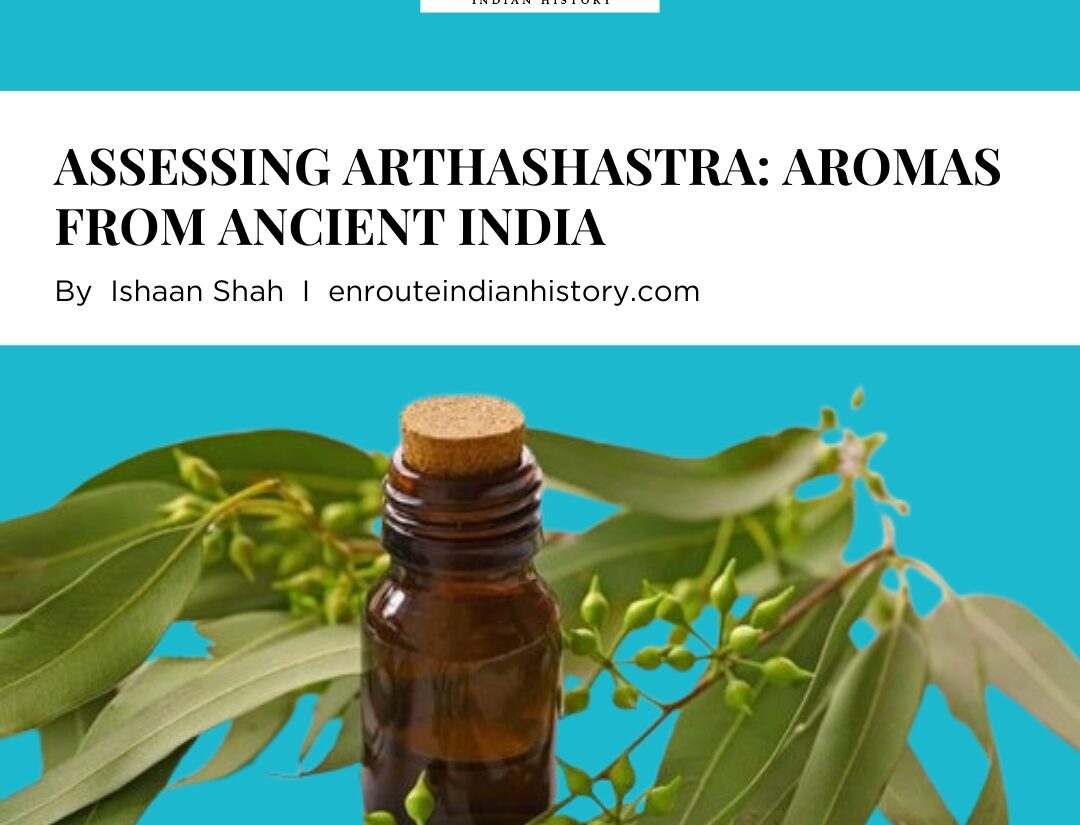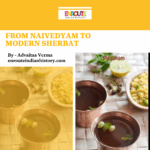Assessing Arthashastra: Aromas from Ancient India
- EIH User
- July 26, 2024

Perfumes and their fragrances are inextricably linked to one’s life today. Historically, these aromas were crucial for enhancing appearances as well as serving medicinal purposes in Ancient India and the text of Arthashastra is replete with mentions of various kinds, which underlies the importance of these aromas in the Indian culture, apart from what Arthashastra is generally associated with.
It is unreasonable to leave the house without wearing perfume these days. These aromas are instrumental in defining an individual’s tastes and shaping a person’s social interactions. It also enhances one’s sartorial choices, where different scents suit different garments. Well, this is not a new age tendency, but was prevalent in the ancient period too. Many ancient Indian texts symbolise the importance of various aromas, that are historic Indian fragrances, and the text of Arthashastra is no different- a shift in perspective as it is known majorly as a political treatise. This text mentions various types of historical scents of India, that one adores so much today, for example, oud. It also curiously mentions various types of sandalwood or chandan, which is commonly found in various forms, in Indian households today. Arthashastra, however, is essentially a Sanskrit treatise written on military strategy and statecraft. Initially composed, then expanded and edited between the 2nd century BCE and the 3rd century CE, this text was prevalent till the 12th century CE when it got lost. It was then rediscovered by R. Shamasastry in 1905 who published it in 1909. This text is attributed to the work of Kautilya, known popularly as Chanakya, who played an instrumental role in ascending Chandragupta Maurya to the finding of the Mauryan Empire (322-185 BCE). This work is a kind of handbook for the king to rule effectively over a kingdom with the encouragement of direct action in addressing concerns of a political nature. The journey to uncover the roots of Ancient Indian aroma culture through assessing this political work enhances one’s curiosity and appreciation for the products used in daily life, which are imbued with precious historical value.
HISTORICAL REFERENCES OF ANCIENT INDIAN PERFUMES
Before plunging into fragrance history in India with a focus on Arthashastra perfume culture, it is essential to take note of other historical references and evidence of ancient Indian perfumes, that reflect their significance in shaping the contours of Indian culture.
This prized item, perfume, which charms millions of people in different ways and forms, dates back to the Harappan Civilization when a distillation apparatus was excavated from the Indus Valley by archaeologist Dr. Paolo Rovesti that was made out of terracotta along with oil containers, carbon-dated to 3000 BCE. That’s not all. Ancient Ayurvedic texts such as the Charaka Samhita and Sushruta Samhita also mention the earliest distillation of ancient Indian scents and attar. The Brihat Samhita, authored by an Indian astronomer and mathematician, Varamihira, mentions various perfumes, their sources, and technique of preparation under ‘Gandhayukti’– which denotes the science and art of perfumery.
The Vedic texts further mention flower garlands as srak and the sons of Sun God, the Ashvins wearing lilies garlands. Furthermore, the Rig Veda mentions Anjana as an eye lotion, some perfumed ointments as punya gandha, and garlands of flowers or suvasah. Atharvaveda also mentions fragrant drugs such as a scented rhizome called Kushta that was significant in curing many ailments and enhancing longevity. Traditional Indian fragrances were perpetuated in the socio-cultural fabric of the nation as one also finds mention of various fragrant drugs and scented articles in the epics such as the Ramayana, where one such instance is that when Bharata went to see Rama in the forest, the path was scented with flowers and sandal water. The Mahabharata also mentions perfumes in the form of incense or dhupas, perfumed oil lamps, and aromatic powders for the body and face, and one such mention is that of Duryodhana who boasts the wealth of perfumes, sandalwood, and aloe wood as a tribute he heaped on.

(Source- LinkedIn, Distillation Apparatus from the Indus Valley)
As for Buddhism, the monks were prohibited from using perfume oil and anointing over the body. However, one Buddhist text in Pali mentions procedures for anointment with perfumes and putting aromatic talcum powder over the face. Interestingly, a medieval text Ni’matnama or the ‘Book of Delights’ highlights the importance of fragrances and sensory pleasure for Indian elites. Ghiyath Shahi authored it, which mentions recipes for rosewater essences and different oils. It upheld the enhancement of luxurious living associated with scents and described how the ruler’s love of perfumes evoked his sensual pleasures. This concept is not alien to people today as some fragrances reflect royalty and luxury in their fragrances, such as the fragrances from Kannauj, Uttar Pradesh.
All these references reiterate the rich value of perfumes and scented articles in ancient times, which are now so common and are taken for granted for their ready availability. It is ideal to pause and ponder over these traditional Indian perfumes, that form the core of ancient Indian aroma culture, used for various purposes and available in different varieties.
ARTHASHASTRA AND ANCIENT PERFUMES- SENSATIONAL SANDALWOOD
As mentioned earlier, Arthashastra is essentially an ancient work on statecraft and economic policy but it does mention various types of aromas, giving a glimpse into the features of these historic Indian fragrances. These fragrant drugs are described in the 11th Chapter- ‘Examination of Gems that are to be entered into the Treasury’ of Book 2 of Arthashastra. It first mentions chandana or sandalwood that was externally applied in those days as Anulepana as well as a fragrant material and cosmetic. This aromatic drug is not unknown in the contemporary period and the Indian Chandan (Santalum album) is grown in southern Indian states such as Karnataka, Kerala, and Tamil Nadu. But not all types of sandalwood trees are fragrant! There is Red chandan which is native to Eastern Ghats of South India and is known for its bright red color. Another species of sandalwood in India is the Swet Chandan which boasts a lot of medicinal properties known to cure common ailments such as common

(Source-Onszaden, Indian sandalwood plant)
cold, fever, and headaches. Well, there is another fragrant variant too, known for its sweetness- Malayagiri Chandan, native to the Western Ghats of South India.
The Arthashastra characterizes sandalwood as moist, and light with a soft touch that makes it as shiny as ghee. It smells pleasant and is adhesive to the skin due to its characteristic to absorb heat. The text mentions various types of sandalwood with their respective characteristics. This list represents the sheer variants and diversity of a single aroma that was probably enjoyed in the ancient period! The list begins with a red-colored chandana with an earthy smell or Satana. The next on the list is Gosirshaka which is dark red and has the smell of a fish. Kautilya then mentions an interesting variant which has the color of the parrot’s feathers (bright green) and the fragrance is that of tamarind or mango! And this is Harichandana.
Getting back to the contemporary period, Indian sandalwood oil is historically significant as the Brihat Samhita records more than 1,000 cosmetic combinations that contain sandalwood. If one would like to look brighter and healthier, then sandalwood isn’t something to miss! It is fascinating to know that sandalwood oil has anti-aging properties too! It blocks the activity of enzymes that enhance skin tissue inflammation and stimulates the deactivating enzyme. It also charges the protein production that blocks the oxidation process, which causes wrinkles. It furthermore inhibits enzymes producing melanin that causes skin pigmentation, thereby reducing it and elevating the brightness of the skin.
Getting back into the ancient world visualized by Arthashastra, the text mentions Tarnasa and Grameruka which is red or dark red and its smell resembled that of a goat’s urine! That certainly seems strange in the present day! Moving away from this pungent smell, it mentions a pretty variant of sandalwood, that is Daivasabyeya which is again red but smells like a lotus. Other variants of sandalwood are red or dark red too and soft and these are Aupaka, Jongaka, and Taurupa.
Nowadays, there are a lot of distractions around the world today due to which there is a lack of complete focus. But, isn’t it wonderful to know that sandalwood oil can increase focus and alertness? A study found that though the oil physically relaxes the body, it stimulates behavior. This is attributed to the fact that the rate of alertness increases with higher decreases in systolic blood pressure. This study shows that the molecules of this ancient Indian scent

(Source- Quora, Sandalwood Oil)
interact positively with receptors of the brain responsible for memory and learning. So next time if someone is distressed due to a lack of focus, they know now what to do!
Moving on with Arthashastra’s mentions of sandalwood, one of the historical scents of India, it further mentions a reddish-white variant called Maleyaka. Another type of chandan is the Kuchandana which is black or dark red with a rough texture. Additionally, it mentions a bud-shaped (attributed to a mountain of the same shape) and black variant called the Kosakaraparvataka.
In the current context, pollution causes widespread damage to the skin as much as to the environment. The toxic gases increase inflammation and oxidation. Sandalwood oil has both anti-inflammatory and anti-oxidization properties which assist in preventing skin damage and making repairs if required. Skin also deteriorates after UV and blue light exposure and sandalwood oil assists in the repairing of this damage and skin pigmentation.
Lastly, the Arthashastra mentions one more variant of sandalwood that smells like a lotus but this is black in color and soft in texture, which is Sitodakiya. It goes on to describe a rough type whose color (green) is compared to that of Saivala or tape grass (Vallisneria), called the Nagaparvataka (probably from the Naga mountain) and the last but not the least is the variant of sandalwood in brown, Sakala.
In addition to the use of sandalwood in perfumes and skincare such as face masks, lotions, and soaps (as the text mentions that this is adhesive to the skin), its properties assist in aromatherapy in the present day which promotes calmness and reduces anxiety. This scent helps in the calming of the nervous system and enhances the quality of sleep. In the present context, it holds undeniable pre-eminence in Ayurveda for its anti-microbial properties and this is applied to treat various skin ailments and wounds. Sandalwood among the traditional Indian fragrances is also utilized for religious purposes as burning agarbattis or dhoop or incense to promote a peaceful atmosphere, owing to the calmness that this scent emits.
Amongst the perfumes in Arthashastra and the historic Indian fragrances, sandalwood has enjoyed a pre-eminent position right from ancient times, till now for different uses which highlights its perpetual role in fashioning out a fragrant Indian perfume culture.
ENCHANTING OUD PERFUME IN ARTHASHASTRA
The aroma of Oud, amongst ancient Indian perfumes, charms many. This perfume is not alien to us either and has been instrumental in defining luxury and royalty with its rich fragrance. Oud, also known as agarwood or agaru (Aquilaria agallocha Roxb.) is also grown in some pockets of South and Southeast Asia such as India, Thailand, Malaysia, China, and Indonesia. This agarwood is the most expensive wood in the world and so is the oud oil that is extracted from the tree. Due to its highly prized value, oud surpassed the price of gold and it was often called the ‘black gold’ in the past. As for India, this plant, among the traditional Indian fragrances, grows in the evergreen forests of the Eastern Himalayas where it is found in plentitude in the Northeastern states of India notably Assam, Meghalaya, Manipur, Sikkim, and Nagaland.
The Arthashastra text holds no qualms in mentioning this fragrant drug that continues to entice the tastes of people even today. The ancient treatise characterizes agaru as being soft and shiny, along with heavy with a far-reaching smell that burns at a slow pace and emits smoke continuously while burning. This scent is of a uniform smell and heat absorbent, along with being skin adhesive, and unremovable even by rubbing. Well, it is due to all these features that oud helps currently in the hydration of the skin and revival of skin tissues. An oud-based moisturizer works wonders on dry skin which is not oily and maintains the humidity level between the skin and the external environment.

(Source- Scroll, Agarwood Trees)
This woody fragrant item is of only 3 types in the Arthashastra. It is described as Jongaka, having a black color with variegated spots, and Dongaka as only black. The Parasamudraka type of agaru is of variegated color and smells like jasmine (Navamalika) or cuscus (Vetiver).
Even though this much-prized fragrance is mentioned briefly in the Arthashastra, using it and exploiting its benefits in the present day enhances our acknowledgment of this historic fragrance of India. Apart from its obvious usage in the perfume and the incense industry, it can be mixed with other herbs of medicinal value, that are known for their anti-microbial properties. This scent is beneficial for ailments like fever, asthma, headache, inflammation giddiness, and skin diseases like eczema, itchiness, and blisters. Like sandalwood, the oil of this fragrance is used to induce calmness and relieve stress in aromatherapy (such as in Arabian medicines). This in turn helps to improve one’s mental and emotional well-being.

(Source- IndiaMart, Oud Fragrance Oil)
Agaru is relevant in Ayurveda for the treatment of cough, and indigestion, the prevention of jaundice, the purification of blood, the healing of wounds, treatment of diarrhea, etc. Just like sandalwood, oud also boasts qualities whose oil helps generate new skin cells, thereby reducing the aging properties of the skin. Isn’t it appealing to use oudh-based cream when stepping out in the sun? Yes, oud has UV protective features like cinnamic acid that form a part of sunscreen lotions.
Agarwood holds immense value in Hinduism when the Mahabharata mentions it as an offering to welcome visitors. The epic further highlights the use of this scent as a display of wealth in the amphitheater (the moat smelled of black agarwood) of the capital of King Drupada, which was Kamapilya. Other mansions surrounding this structure also were fragrant with rich agarwood. The tribes who were vanquished by the Bharatas people had to pay a tribute of valuables such as sandalwood and agarwood. This woody scent holds significance in Christianity too where it is used with myrrh in the anointment of Jesus Christ before his crucifixion, as mentioned in the Holy Bible.
As for Buddhism, this fragrance was used amongst other traditional Indian fragrances in the cremation of the Gautama Buddha. Even in Islam, the scent serves an important purpose in the ritual that involves the burning of incense which signifies spiritual purification. The preferred scent of the Prophet was agarwood mixed with camphor.
This fragrance too, amongst other historic fragrances of India, boasts a rich heritage in India for its properties and diverse uses that are relevant in the present-day for not only beautification but also better physical and mental well-being.
ARTHASHASTRA AND EUCALYPTUS
After a fragrant journey into the ancient Indian aroma culture, it is essential to explore one more fragrant drug that Arthashastra mentions which is ‘Taila Parnika’ or Eucalyptus (E. globulus). This is not an unknown scent either and plays an important role, for example, in the common cold such as clearing nasal congestion.
‘Taila Parnika’ is known for its minty and camphorous scent and is suitable for natural air purifiers due to its deodorant and antibacterial properties. Interestingly, the text also mentions

(Source- Roundglass Sustain, Eucalyptus Plantations)
that just like sandalwood, this scent was also used as a beauty aid and as Anulepana (to be applied externally). This tree is an evergreen one and is found in Indian states like the Nilgiris in Tamil Nadu, Gujarat, Haryana, and Kerala.
The Arthashastra mentions various types of eucalyptus starting with an interesting variant that is of meat color and smells like a lotus, and called it Asokagramika. Next comes another sensorily appealing type that is Jongaka which smells like a blue lotus or a cow’s urine and is reddish yellow. Kautilya also mentions Grameruka, smelling of the urine of a cow and is greasy in texture.
Currently, where respiratory ailments are common such as asthma and bronchitis, eucalyptus oil is used for its properties in the clearing of mucus from the airways. This fragrant drug, among ancient Indian perfumes, boasts antiseptic and anti-inflammatory properties, making it ideal to treat burns, wounds, and insect bites (this acts like a natural repellent) and be used in ointments and pain relief balms for treating joint and muscle pain.
The above three types are not the only ones mentioned in the Arthashastra. It mentions Sauvarnakudyaka, which is reddish yellow and smells like citron (Citrus medica Linn) or Matulunga. A type of scent that smells like lotus or butter is Purnadvipaka. Other kinds of Eucalyptus with a nutmeg color and smell like costus (a plant- Saussurealappa) or Kushtha are Bhadrasriya and Paralauhityaka.
As a part of its contemporary usage, the eucalyptus plant is used in various small-scale industries in rural areas such as jaggery making, tile manufacturing, pottery, dyeing, brick making, etc. Eucalyptus wood is also used in the paper and pulp industry. These industries require charcoal or firewood that is provided by the plantations of eucalyptus. Plantations have been a decisive factor in the flourishing of these rural industries, such as in the Kolar district (Karnataka).

(Source- Exporters India, Eucalyptus Oil)
The text mentions more 3 varieties of eucalyptus where one is in the color of cuscus or Vetiver (green) and this one smells again like costus, which is Antaravatya. The last two types are Kaleyaka and Auttaraparvataka (from the northern mountains), which are yellow as well as greasy and reddish respectively.
Additionally, the ancient text mentions that the smell of this drug is long-lasting, regardless of whether it being made into a paste or burnt or boiled. The smell remains constant even when mixed with other items that contain qualities of sandalwood and agarwood.
Apart from using eucalyptus in cosmetics, skincare, and aromatherapy, isn’t it captivating enough to know that its leaves can keep one’s dental health in check? Yes, eucalyptus leaves contain compounds that are related to reduced levels of bacteria that cause gum diseases and cavities. Well, the mouthwash one uses after brushing contains eucalyptol for this reason.
This is not a fragrance that increases anxiety or mental uneasiness. On the contrary, it is widely believed that eucalyptus reduces the symptoms of stress. Inhaling its oil for 30 minutes can lower blood pressure after knee surgery, which reflects the calming effect of this aroma, among the historical scents of India. This aroma is believed to decrease the activity of the stress response system- the sympathetic nervous system and activates the parasympathetic nervous system, which is responsible for relaxation and calmness.
It is well-established that this minty scent garnered appreciation right from ancient times and in the present context, it is used evidently for purposes ranging from personal usage to industrial purposes, underlying its ever-increasing relevance for the future too.
An exhilarating journey through the historical scents of India cultivates a sense of admiration for the products of those scents, that one uses every day without a second thought of its origins. The wider prevalence of sandalwood, oud, and eucalyptus currently is a testament to its properties and benefits, aiding generations after generations and even being superior enough to be entered into the royal treasury, as Arthashastra mentions. These historic Indian fragrances not only receive admiration in the form of bottled perfumes but also in other forms that possess health benefits and are significant in the religious spheres too in addition to enhancing outward appearances. Therefore, owning or utilizing these fragrances in some form or the other only helps one to acknowledge the rich historic legacy these scents have imparted to the perfume culture of India.
REFERENCES AND BIBLIOGRAPHY
Das. P, Bajpai. N, INDIAN HISTORY OF PERFUME, ITS EVIDENCES AND EVOLUTION FROM DIFFERENT ERA, (2021), International Journal of Creative Research Thoughts
https://ijcrt.org/papers/IJCRT2111056.pdf
Kautilya’s Arthashastra, translated by R. Shamasastry, Eighth Edition, Mysore Printing and Publishing House (1967)
https://thedailyguardian.com/history-of-perfume-in-india/#:~:text=Kautilya’s%20Arthashastra&text=Arthashastra%20has%20the%20descriptions%20of,beauty%20aid%20and%20fragrant%20material.
https://www.thieme.in/image/catalog/Sample%20Chapter/Sample_Chapter_GOMP.pdf
https://www.wisdomlib.org/hinduism/book/kautilya-arthashastra/d/doc366057.html
https://indiagardening.com/types-of-chandan-trees-sandalwood-varieties/
https://quintis.com.au/q-lab-knowledge-centre/sandalwood/benefits
https://www.healthline.com/nutrition/eucalyptus-leaves#TOC_TITLE_HDR_2
https://nopr.niscpr.res.in/bitstream/123456789/60616/1/SR%2059%2810%29%2046-47.pdf
https://www.attarperfume.com/oud-attar-uses-history-spiritual-benefits/
https://www.fao.org/4/AC772E/ac772e06.htm
https://www.worldhistory.org/Arthashastra/
https://allgoodscents.com/blogs/all-good-notes/history-of-indian-fragrances
https://www.herzindagi.com/society-culture/benefits-of-oudh-fragrance-origin-how-to-pick-the-genuine-tips-article-175551
https://www.netmeds.com/health-library/post/agaru-agarwood-uses-benefits-doshas-dosage-precautions-and-side-effects
https://indicanaoud.com/blogs/historical-accounts-of-agarwood/agarwood-in-various-religions#:~:text=Agarwood%20was%20often%20identified%20in,sweet%20scent%20of%20burning%20agarwood.%E2%80%9D
http://www.ecoindia.com/flora/trees/eucalyptus-tree.html#:~:text=Location%20%3A%20It%20is%20widely%20grown,Bandipur%20National%20Park%20in%20India.%20.
https://www.ncbi.nlm.nih.gov/pmc/articles/PMC2374764/
https://openknowledge.fao.org/server/api/core/bitstreams/cd7ebb4f-da7c-474d-83df-b5cc224d2ff8/content
International Journal of Forestry Research
https://www.auromere.com/blog/the-healing-properties-of-chandana-the-indian-sandalwood-tree/
https://provisionscents.com/blogs/blog/the-story-of-indian-sandalwood
IMAGE REFERENCES
https://www.linkedin.com/posts/amit-shukla-mergers_distillation-apparatus-of-3000-bc-from-activity-7144529554483601408-dPCs
https://www.quora.com/What-are-the-benefits-of-Indian-sandalwood-essential-oil
https://onszaden.com/Santalum_album
https://scroll.in/article/898749/facing-extinction-indias-scented-agarwood-is-finding-ways-to-grow-in-home-gardens-polluted-fields
https://www.indiamart.com/proddetail/oud-fragrance-oil-23162847262.html
https://roundglasssustain.com/conservations/economy-or-ecology-eucalyptus-plantations-in-coastal-andhra-raises-concern
https://www.exportersindia.com/product-detail/yellow-eucalyptus-oil-5819466.htm

















